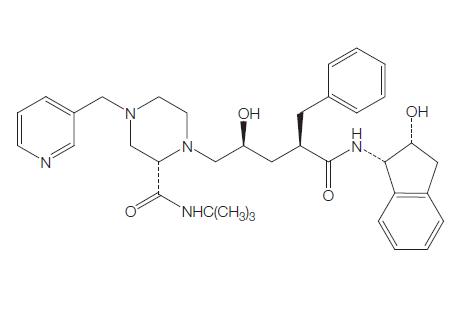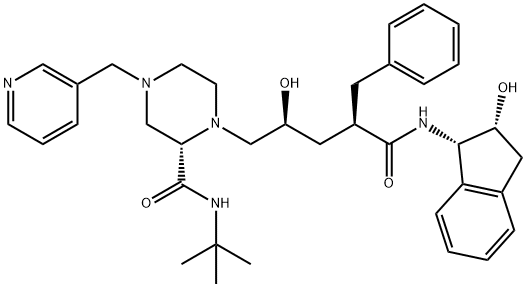Side effects of Indinavir
Apr 1,2022
Indinavir is formulated as a sulfate salt and is available from the manufacturer for oral administration in strengths of 100, 200, 333, and 400 mg of indinavir. Indinavir sulfate is a white to off-white, hygroscopic, crystalline powder with the molecular formula C36H47N5·H2SO4 and a molecular weight of 711.88 Da. The chemical structure of indinavir is shown below. The molecular weight of indinavir free base is 613.8 Da.
Indinavir, as with the other HIV protease inhibitors, inhibits the processing of viral gag and gag-pol polyproteins in HIV-1-infected cells by selectively inhibiting the activity of the HIV-1 protease, resulting in the production of immature virions which are replication incompetent. Indinavir is active against HIV-1 and to a lesser degree against HIV- 2.Indinavir is available for oral administration only and there is no parenteral formulation.

Uses
Indinavir has been used solely for the treatment of HIV-1 infection, but in many settings it has now been replaced by other agents. In highincome countries, indinavir is now almost a forgotten drug. In the most recent revision of the USA Department of Health and Human Services (DHHS) guidelines, it does not appear in the list of recommended protease inhibitors. However, the use of lower indinavir doses, and in particular the use of a ritonavir-boosted dose of 400/100 mg twice daily, has the potential to provide reasonably affordable access to a boosted-protease inhibitor in low- and middle-income countries where cost is a major barrier to antiretroviral treatment.
Medication mode and dosage
The recommended dosage of indinavir is 800 mg (usually as two 400 mg capsules) taken every 8 hours. Because food affects its absorption, indinavir should be ingested without food, 1 hour before or 2 hours after a meal. For optimal absorption, the manufacturer recommends ingestion with water or alternatively skimmed milk, juice, coffee, tea, or with a light meal. Because indinavir-associated nephrolithiasis may be related to inadequate hydration, the recommendation is that individuals receiving indinavir should ingest at least 1.5 liters of fluid during the course of a 24-hour dosing cycle.
Side effects
Indinavir is associated with specific adverse effects, as well as general adverse effects described for the HIV protease inhibitors as a class. The main specific adverse effects associated with the use of indinavir are hyperbilirubinemia, nephrotoxicity, and cutaneous toxicities. The main general adverse events associated with the protease inhibitors as a class include gastrointestinal disturbance, hypersensitivity reactions, hepatotoxicity, paresthesias, and lipodystrophy.
Nephrotoxicity
Crystalluria, crystal nephropathy, nephrolithiasis, interstitial nephritis, and lower urinary tract inflammation have all been described in association with indinavir usage. The nephrotoxicity of indinavir generally falls into two syndromes, one a syndrome of acute nephrolithiasis and the other of chronic indolent renal impairment.
- Related articles
- Related Qustion
Ritonavir is a peptidomimetic inhibitor of HIV-1 and HIV-2 proteases. It is marketed by Abbott Laboratories under the brand name Norvir.....
Apr 1,2022APINelfinavir is used primarily for the treatment of HIV-1 infection, but has also been recently used in patients with malignancy.....
Apr 1,2022APIIndinavir
150378-17-9You may like
- Indinavir USP/EP/BP
-

- $1.10 / 1g
- 2025-11-18
- CAS:150378-17-9
- Min. Order: 1g
- Purity: 99.9%
- Supply Ability: 100 Tons Min
- Indinavir
-

- $1520.00 / 25mg
- 2025-07-15
- CAS:150378-17-9
- Min. Order:
- Purity:
- Supply Ability: 10g
- Indinavir
-

- $120.00 / 1kg
- 2025-05-26
- CAS:150378-17-9
- Min. Order: 1kg
- Purity: 0.99
- Supply Ability: 1000000






